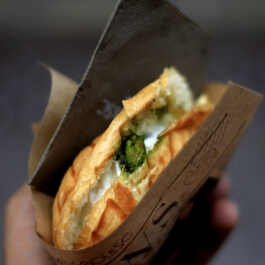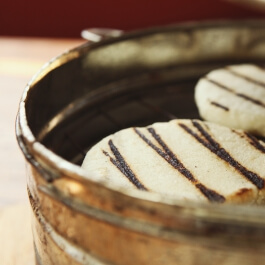Food
Hall Of Flame: The World’s Spiciest Condiments
1Maybe it’s to encourage sweating, maybe it’s to stimulate the appetite on scorching-hot days – whatever the reason, we can’t help but notice that the world’s warmest regions are home to the world’s ‘hottest’ cuisines. As summer heats up, we look to them for inspiration on sauces, dips, relishes and rubs that will add a spicy note to any dish – and a bit of sweat to your brow.
By Jessica Keller
0/17
Food
Hall Of Flame: The World’s Spiciest Condiments.
2Chakalaka, South Africa – Want to fit in with the locals? Be sure to bring this spicy vegetable relish to your next braai (barbecue). Chakalaka is believed to have been invented in the Johannesburg mining towns, where workers would cook up canned beans with whatever vegetables they had on hand, adding chilies for a hefty amount of zing. Make your own (or find it here), and serve with meat and pap (maize-based porridge).
1/17
Food
Hall Of Flame: The World’s Spiciest Condiments.
2Berbere, Ethiopia – A unique blend of spices both familiar (chili peppers, garlic, ginger, cumin, fenugreek) and exotic (ajwain, nigella, radhuni, korarima), berbere is the bedrock of many Ethiopian recipes. It can be added to a variety of dishes before or after cooking for an unmistakable zest – try sprinkling it on French fries, adding to lentil stews, or stir it into a made-from-scratch ketchup. [Photo: Sarah R/Flickr]
2/17
Food
Hall Of Flame: The World’s Spiciest Condiments.
3Shito, Ghana – If you like your condiments the same way you like your coffee, then this hot black sauce is your new prandial sidekick. The exact ingredients vary by region – having originated with the Ga tribe – but are more or less fish-based (think fish oil, dried fish, prawns and/or crustaceans) with a mixture of other spices, such as garlic and ginger, and an audacious amount of peppers. It’s often seen being treated like a spicier, more sea-flavoured ketchup. [Photo: Tim Lawrenz/Flickr]
3/17
Food
Hall Of Flame: The World’s Spiciest Condiments.
5Harissa, North Africa – This spicy paste takes no prisoners, which can be expected considering its main ingredient is hot chili peppers, often smoked. Further flavour complexity is added through herbs and spices like saffron, caraway, coriander, cumin, garlic and mint, for a paste that can pep up anything from hummus to mayo, soups, pizza sauces, sandwich spreads and meat marinades. Basically, just slather this stuff on anything that doesn’t hurt enough already. [Photo: Michael Verhoef/Flickr]
4/17
Food
Hall Of Flame: The World’s Spiciest Condiments.
6Acı biber salçası, Turkey – An Anatolian staple, this pepper paste is strikingly simple, consisting primarily of hot chili peppers that have been de-seeded and de-stemmed, then crushed and dried in the sun for several days. It’s useful for livening up dishes, filling börek and pide, or spreading on crackers and bread. [Photo: Wikimedia Commons]
5/17
Food
Hall Of Flame: The World’s Spiciest Condiments.
7Bomba Calabrese, Italy – Local hot cherry peppers are the lethal component of this “Calabrian bomb” sauce, joined by olive oil and assorted veggies – like mushrooms, sun-dried tomatoes, artichokes or pepperoncini – for a zesty companion to pasta, bruschetta and pizza. amazon.com
6/17
Food
Hall Of Flame: The World’s Spiciest Condiments.
8Piri-Piri Sauce, Portugal – Swahili for “pepper pepper”, the piri-piri chili pepper is native to southern African countries like Angola and Mozambique – which were once Portuguese colonies. In Portugal, these tiny peppers are blended with garlic, olive oil and lemon juice to create a marinade for grilled chicken, in what has become something of a national dish. [Photo: Wikimedia Commons]
7/17
Food
Hall Of Flame: The World’s Spiciest Condiments.
9Tabasco, Louisiana (USA) – If, like Beyoncé, you carry hot sauce in your bag, there’s a good chance it’s Tabasco. Generally regarded as the original hot sauce brand, this distinctive, 140-year-old Louisiana-style sauce is made from tabasco peppers that have been aged in oak whisky barrels for up to 3 years, then combined with vinegar and salt, packaged in a distinctive bottle and enjoyed around the world. tabasco.com [Photo: Michael Saechang/Flickr]
8/17
Food
Hall Of Flame: The World’s Spiciest Condiments.
10El Yucateco, Mexico – El Yucateco makes a variety of Mexican-style habanero hot sauces from their base in the Yucatán region. The red sauce is their award-winning product, perfect for pouring on seafood or mixing in a Bloody Mary, while the black sauce offers a smoky flavour that begs to be paired with steak, and the unforgiving Kutbilik sauce will make you breathe fire. elyucateco.com
9/17
Food
Hall Of Flame: The World’s Spiciest Condiments.
11Anything With Malaguetas, Brazil – Punishingly hot malagueta peppers (larger versions of piri-piri peppers) are key players in Brazilian cuisine; they’re so potent, in fact, that it’s advisable to wear rubber gloves when cooking with them. Especially in the Bahia region, malaguetas are often preserved in oil or sautéed with onions and ginger for an accompaniment that goes with nearly everything – and won’t leave a dry eye at the table. [Photo: woodleywonderworks/Flickr]
10/17
Food
Hall Of Flame: The World’s Spiciest Condiments.
12Jerk, Jamaica – Jamaican cuisine is all but synonymous with this frisky spice rub starring red-hot Scotch bonnet peppers and allspice (or “pimento”, in Jamaica) with supporting roles often played by cinnamon, garlic, ginger, nutmeg, thyme, cloves, salt and even brown sugar. In authentic island cuisine, meat is rubbed with or marinated in the spice mixture before being cooked, but you could also incorporate the spices into a sauce to pour on anything that could use a good kick in the pants. [Photo: m01229/Flickr]
11/17
Food
Hall Of Flame: The World’s Spiciest Condiments.
13Achaar, India – Literally meaning “pickles” in many Indian languages, what constitutes achaar varies widely across the subcontinent, with mangoes being the most popular food to preserve as a condiment. Telangana State in South India are known for infusing their achaar with some sting, pickling unripe mangoes with garlic, ginger and tamarind, or going whole hog with jars full of pickled green or red chilies.
12/17
Food
Hall Of Flame: The World’s Spiciest Condiments.
14Sichuan Chili Oil, China – A godsend for time-poor spice-lovers, this beloved condiment – ubiquitous to the cuisine of Sichuan Province – is so easy to make. All you need is some oil (peanut or grape seed are ideal), pepper (Sichuan peppercorns and crushed red pepper flakes), a few aromatic spices (star anise, cinnamon, bay leaves, etc.) and a jar. Just simmer the oil, peppercorns and aromatics, then strain and add the pepper flakes to the fragrant oil, along with a dash of salt. Voilà, your new favourite add-on. Get the full recipe here thewoksoflife.com [Photo: Alpha/Flickr]
13/17
Food
Hall Of Flame: The World’s Spiciest Condiments.
15Sambal, Southeast Asia – Particularly beloved in Indonesia and Malaysia, this condiment comes in hundreds of different varieties, but they all have one thing in common: an amount of chili pepper that’s downright deviant. The peppers and other ingredients (which vary greatly by region but tend to include garlic, tomato and shallots) are traditionally hand-ground in a mortar and pestle and served aside all kinds of dishes, from meats to noodles, soups, stews and rice. [Photo: Tejo Damai Santoso/Flickr]
14/17
Food
Hall Of Flame: The World’s Spiciest Condiments.
16Gochujang, Korea – If you love kimchi and pain in equal measure, then you need to try this fermented household mainstay. Combining red chili with fermented soybeans, glutinous rice and salt, gochujang has a complex, pungent flavour that somehow manages to be sour, sweet and spicy all at once. Use it as a marinade or a dipping sauce, or mix it with rice vinegar, sesame oil and sugar for a salad dressing with a vengeance (or use a less spicy version for a gentler kick).
15/17
Food
Hall Of Flame: The World’s Spiciest Condiments.
17Wasabi, Japan – A favourite of sushi lovers and people with clogged sinuses everywhere, wasabi is the more hardcore cousin of the horseradish and grows under very particular conditions, making true wasabi plants scarce and expensive. A less costly alternative to the fresh stuff is wasabi powder – look for one made from 100% pure Wasabia japonica – which can be mixed with cold water to form a paste. Use it in salad dressings, marinades, sandwiches and sauces …but beware. [Photo: Quinn Dombrowski/Flickr]
16/17
Food
Hall Of Flame: The World’s Spiciest Condiments.
1917/17















Sorry, the comment form is closed at this time.